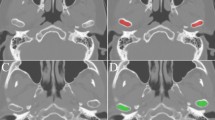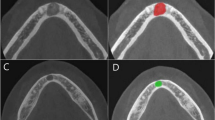Abstract
Objectives
Despite the difficulty in distinguishing between squamous cell carcinoma (SCC) and medication-related osteonecrosis of the jaw (MRONJ) on the basis of medical imaging examinations, the two conditions have completely different treatment methods and prognoses. Therefore, differentiation of SCC from MRONJ on imaging examinations is very important. This study aimed to distinguish SCC from MRONJ by performing texture analysis using magnetic resonance imaging (MRI) short-tau inversion recovery images.
Methods
This retrospective case–control study included 14 patients with SCC of the lower gingiva and 35 with MRONJ of the mandible who underwent MRI and computed tomography (CT) for suspected SCC or MRONJ. SCC was identified by histopathological examination of tissues excised during surgery. The radiomics features of SCC and MRONJ were analyzed using the open-access software MaZda version 3.3 (Technical University of Lodz, Institute of Electronics, Poland). CT was used to evaluate the presence or absence of qualitative findings (sclerosis, sequestrum, osteolysis, periosteal reaction, and cellulitis) of SCC and MRONJ.
Results
Among the 19 texture features selected using MaZda feature-reduction methods, SCC of the gingiva and MRONJ of the mandible revealed differences in two histogram features, one absolute gradient feature, and 16 Gy level co-occurrence matrix features. In particular, the percentile, angular second moment, entropy, and difference entropy exhibited excellent diagnostic performance.
Conclusion
Non-contrast-enhanced MRI texture analysis revealed differences in texture parameters between mandibular SCC and mandibular MRONJ. MRI texture analysis can be a new noninvasive quantitative method for distinguishing between SCC and MRONJ.


Similar content being viewed by others
Data availability
The data that support the findings of this study are available from the corresponding author, upon reasonable request.
References
2016syourei_houkoku.pdf. Available from: http://www.jshnc.umin.ne.jp/pdf/2016syourei_houkoku.pdf
Tocaciu S, Breik O, Lim B, Angel C, Rutherford N. Diagnostic dilemma between medication-related osteonecrosis and oral squamous cell carcinoma in a mandibular lytic lesion. Br J Oral Maxillofac Surg. 2017;55:e53–7.
Li Q, Cui H, Dong J, He Y, Zhou D, Zhang P, et al. Squamous cell carcinoma resulting from chronic osteomyelitis: a retrospective study of 8 cases. Int J Clin Exp Pathol. 2015;8:10178–84.
Alami M, Mahfoud M, El Bardouni A, Berrada MS, El Yaacoubi M. Squamous cell carcinoma arising from chronic osteomyelitis. Acta Orthop Traumatol Turc. 2011;45:144–8.
Caruso G, Gerace E, Lorusso V, Cultrera R, Moretti L, Massari L. Squamous cell carcinoma in chronic osteomyelitis: a case report and review of the literature. J Med Case Reports. 2016;10:215.
Saglik Y, Arikan M, Altay M, Yildiz Y. Squamous cell carcinoma arising in chronic osteomyelitis. Int Orthop. 2001;25:389–91.
Moura DL, Ferreira R, Garruço A. Malignant transformation in chronic osteomyelitis. Rev Bras Ortop. 2017;52:141–7.
Stockmann P, Hinkmann FM, Lell MM, Fenner M, Vairaktaris E, Neukam F-W, et al. Panoramic radiograph, computed tomography or magnetic resonance imaging. Which imaging technique should be preferred in bisphosphonate-associated osteonecrosis of the jaw? A prospective clinical study. Clin Oral Investig. 2010;14:311–7.
Guggenberger R, Fischer DR, Metzler P, Andreisek G, Nanz D, Jacobsen C, et al. Bisphosphonate-induced osteonecrosis of the jaw: comparison of disease extent on contrast-enhanced MR imaging, [18F] fluoride PET/CT, and Conebeam CT imaging. AJNR Am J Neuroradiol. 2013;34:1242–7.
Kaneda T, Minami M, Ozawa K, Akimoto Y, Utsunomiya T, Yamamoto H, et al. Magnetic resonance imaging of osteomyelitis in the mandible. Comparative study with other radiologic modalities. Oral Surg Oral Med Oral Pathol Oral Radiol Endod. 1995;79:634–40.
Ariji Y, Izumi M, Gotoh M, Naitoh M, Katoh M, Kuroiwa Y, et al. MRI features of mandibular osteomyelitis: practical criteria based on an association with conventional radiography features and clinical classification. Oral Surg Oral Med Oral Pathol Oral Radiol Endod. 2008;105:503–11.
Baba A, Ojiri H, Goto TK, Ikeda K, Yamauchi H, Ogino N, et al. Symposium: imaging modalities for drug-related osteonecrosis of the jaw (4), CT and MR imaging findings of antiresorptive agent-related osteonecrosis of the jaws/medication-related osteonecrosis of the jaw (secondary publication). Jpn Dent Sci Rev. 2019;55:58–64.
Mosquera-Lopez C, Agaian S, Velez-Hoyos A, Thompson I. Computer-aided prostate cancer diagnosis from digitized histopathology: a review on texture-based systems. IEEE Rev Biomed Eng. 2015;8:98–113.
Gao J, Jiang Q, Zhou B, Chen D. Convolutional neural networks for computer-aided detection or diagnosis in medical image analysis: an overview. Math Biosci Eng MBE. 2019;16:6536–61.
Gentillon H, Stefańczyk L, Strzelecki M, Respondek-Liberska M. Parameter set for computer-assisted texture analysis of fetal brain. BMC Res Notes. 2016;9:496.
Lazli L, Boukadoum M, Ait MO. Computer-aided diagnosis system of Alzheimer’s disease based on multimodal fusion: tissue quantification based on the hybrid fuzzy-genetic-possibilistic model and discriminative classification based on the SVDD model. Brain Sci. 2019;9:289.
Liu R, Li H, Liang F, Yao L, Liu J, Li M, et al. Diagnostic accuracy of different computer-aided diagnostic systems for malignant and benign thyroid nodules classification in ultrasound images: a systematic review and meta-analysis protocol. Medicine (Baltimore). 2019;98: e16227.
Ramkumar S, Ranjbar S, Ning S, Lal D, Zwart CM, Wood CP, et al. MRI-based texture analysis to differentiate sinonasal squamous cell carcinoma from inverted papilloma. AJNR Am J Neuroradiol. 2017;38:1019–25.
Dang M, Lysack JT, Wu T, Matthews TW, Chandarana SP, Brockton NT, et al. MRI texture analysis predicts p53 status in head and neck squamous cell carcinoma. AJNR Am J Neuroradiol. 2015;36:166–70.
Soni N, Priya S, Bathla G. Texture analysis in cerebral gliomas: a review of the literature. AJNR Am J Neuroradiol. 2019;40:928–34.
Ye R, Weng S, Li Y, Yan C, Chen J, Zhu Y, et al. Texture analysis of three-dimensional MRI images may differentiate borderline and malignant epithelial ovarian tumors. Korean J Radiol. 2021;22:106–17.
Cai J-H, He Y, Zhong X-L, Lei H, Wang F, Luo G-H, et al. Magnetic resonance texture analysis in Alzheimer’s disease. Acad Radiol. 2020;27:1774–83.
Strzelecki M, Szczypinski P, Materka A, Klepaczko A. A software tool for automatic classification and segmentation of 2D/3D medical images. Nucl Instrum Methods Phys Res A. 2013;702:137–40.
Szczypiński PM, Strzelecki M, Materka A, Klepaczko A. MaZda–a software package for image texture analysis. Comput Methods Programs Biomed. 2009;94:66–76.
Ruggiero SL, Dodson TB, Fantasia J, Goodday R, Aghaloo T, Mehrotra B, et al. American Association of Oral and Maxillofacial Surgeons position paper on medication-related osteonecrosis of the jaw–2014 update. J Oral Maxillofac Surg Off J Am Assoc Oral Maxillofac Surg. 2014;72:1938–56.
Ruggiero SL. Guidelines for the diagnosis of bisphosphonate-related osteonecrosis of the jaw (BRONJ). Clin Cases Miner Bone Metab Off J Ital Soc Osteoporos Miner Metab Skelet Dis. 2007;4:37–42.
Ito K, Muraoka H, Hirahara N, Sawada E, Hirohata S, Otsuka K, et al. Quantitative assessment of mandibular bone marrow using computed tomography texture analysis for detect stage 0 medication-related osteonecrosis of the jaw. Eur J Radiol. 2021;145: 110030.
Lemeshow S, Sturdivant RX Jr, DWH. Applied logistic regression. 3rd ed. Hoboken: Wiley; 2013.
Fatterpekar GM, Emmrich JV, Eloy JA, Aggarwal A. Bone-within-bone appearance: a red flag for biphosphonate-associated osteonecrosis of the jaw. J Comput Assist Tomogr. 2011;35:553–6.
Acknowledgements
This work was supported by JSPS KAKENHI (Grant Number JP21K17101).
Funding
This work was supported by JSPS KAKENHI Grant Number JP21K17101.
Author information
Authors and Affiliations
Corresponding author
Ethics declarations
Conflict of interest
The authors declare that they have no conflict of interest.
Ethical approval
This study was approved by the Ethics Committee of the University School of Dentistry (No. EC21-003).
Informed consent
The requirement to obtain written informed consent was waived for this retrospective study. All procedures followed the guidelines of the Declaration of Helsinki, Ethical Principles for Medical Research Involving Human Subjects.
Animal statements
This article does not contain any studies with animal subjects performed by the any of the authors.
Additional information
Publisher's Note
Springer Nature remains neutral with regard to jurisdictional claims in published maps and institutional affiliations.
Rights and permissions
Springer Nature or its licensor (e.g. a society or other partner) holds exclusive rights to this article under a publishing agreement with the author(s) or other rightsholder(s); author self-archiving of the accepted manuscript version of this article is solely governed by the terms of such publishing agreement and applicable law.
About this article
Cite this article
Ito, K., Hirahara, N., Muraoka, H. et al. Texture analysis using short-tau inversion recovery magnetic resonance images to differentiate squamous cell carcinoma of the gingiva from medication-related osteonecrosis of the jaw. Oral Radiol 40, 219–225 (2024). https://doi.org/10.1007/s11282-023-00725-3
Received:
Accepted:
Published:
Issue Date:
DOI: https://doi.org/10.1007/s11282-023-00725-3




